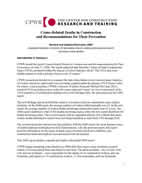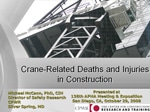Crane-Related Deaths in Construction and Recommendations for Their Prevention (Completed – 2004-2009)
CPWR examined data from the Bureau of Labor Statistics (BLS) in 2008 to evaluate crane-related fatality trends over time and propose necessary changes to prevent injury and death. This new report includes data retrieved through key word searches of BLS data and BLS secondary Source codes.
CPWR researchers decided to re-examine the data used to produce the June 2008 crane report when further review showed many fatalities of workers struck by crane loads were not being counted under the primary CFOI Source codes for cranes.
The new findings almost doubled the number of workers killed in construction crane-related incidents. In the 2008 report, the average number of workers killed annually was 22. In the new report, the average number of worker deaths involving construction cranes was 42 a year. The 2008 report identified a total of 323 deaths involving cranes, while the new report identified 632 deaths involving cranes.
This revised report with its expanded analysis will confirm that many worker deaths attributed to cranes were not being identified as such from 1992 through 2006.
Perhaps most important, the report gives seven recommendations to prevent fatalities and injuries from occurring.

